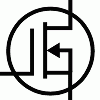
This is what I've been working on in ECE lab this term. There are three seperate boards you see.
- Atmel Tiny26 microcontroller = The green one. These are the brains.
- LED bank. - This was used for a voltmeter project, each LED stood for 1V (They blink if you go over 9v, 10v will fry the chip.
- Accelerometer = This one has the orange wires, and numeric display.
The Accelerometer board is my final project. It is a proof of concept for a wireless joystick for my upcoming Tekbot (robotic learning platform). Right now it is supposed to display which direction it is being tilted on the numeric display. However, it's still glitchy (ie it doesn't work)
Finally, I'd like to point out the actual accelerometer on top of an American dime. That was reeeal fun to solder leads to. (actually I thought it was).
I know it's not furry, but I'm kind of proud of it, and it really is an art to me.
- Atmel Tiny26 microcontroller = The green one. These are the brains.
- LED bank. - This was used for a voltmeter project, each LED stood for 1V (They blink if you go over 9v, 10v will fry the chip.
- Accelerometer = This one has the orange wires, and numeric display.
The Accelerometer board is my final project. It is a proof of concept for a wireless joystick for my upcoming Tekbot (robotic learning platform). Right now it is supposed to display which direction it is being tilted on the numeric display. However, it's still glitchy (ie it doesn't work)
Finally, I'd like to point out the actual accelerometer on top of an American dime. That was reeeal fun to solder leads to. (actually I thought it was).
I know it's not furry, but I'm kind of proud of it, and it really is an art to me.
Category All / All
Species Unspecified / Any
Size 960 x 1280px
File Size 148.1 kB
Thanks Vixyy! That's what is so cool about the Tekbot program. It is almost entirely open-ended. It starts out as a basic two-wheeled robot, but you can add stuff and modify it however you want. No robot wars, unfortunately, at least not an official one. Doesn't mean I'd exclude the possibility of a spinning blade of death. =P
I've only put together a small handful of kits; I can handle through-hole components without too much problem, just have to watch out for solder bridges. Most other electronic nuts in my age group complain that the parts are too small to see!
Spare parts and a well stocked junk box are great things. Anytime I measure wire off for anyone, I say that "The only person slack ever hurt was a bungee jumper."
Haven't really had enough time to tackle Morse yet. If I get far enough into it that I start doing QRP operation, my fursona may change to a pig...
Spare parts and a well stocked junk box are great things. Anytime I measure wire off for anyone, I say that "The only person slack ever hurt was a bungee jumper."
Haven't really had enough time to tackle Morse yet. If I get far enough into it that I start doing QRP operation, my fursona may change to a pig...
Why would you need more than 5W? =P
I haven't actually made a CW QSO, I'm still not terribly confident in my receiving abilities. Although I have plans for a nice little homebrew QRP rig once I can float some cash. http://wiki.tak-40.org/
I haven't actually made a CW QSO, I'm still not terribly confident in my receiving abilities. Although I have plans for a nice little homebrew QRP rig once I can float some cash. http://wiki.tak-40.org/
If you feel like you need a second ear to make sure you got something copied right, try Fldigi. It does a pretty good job with CW, and it's freeware. Probably wouldn't be hard to modify a TAK-40 to work those modes either.
I mostly run BPSK-31 or digital modes on HF - they're perfect for QRP. I've heard stronger signals from QRP stations than many QRO operators.
I've thought about building one or two of the kits from Small Wonder Labs, but decided that a single-frequency radio just wouldn't be interesting enough. So I got a Yaesu 857-D, and haven't looked back too many times. Sometime in the future, when I have more time (HA!) I might build one of those and add a Nue-PSK for a portable contest rig.
I mostly run BPSK-31 or digital modes on HF - they're perfect for QRP. I've heard stronger signals from QRP stations than many QRO operators.
I've thought about building one or two of the kits from Small Wonder Labs, but decided that a single-frequency radio just wouldn't be interesting enough. So I got a Yaesu 857-D, and haven't looked back too many times. Sometime in the future, when I have more time (HA!) I might build one of those and add a Nue-PSK for a portable contest rig.

 FA+
FA+










Comments